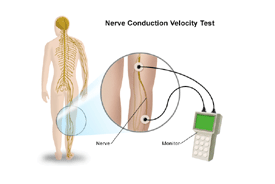Electromyography (EMG):

Electromyography (EMG) is a diagnostic procedure to assess muscles and the nerve cells (motor neurons). Motor neurons transmit electrical signals that cause muscles to contract. An EMG translates these signals into graphs, sounds or numerical values.
EMG results can reveal nerve dysfunction, muscle dysfunction or problems with nerve-to-muscle signal transmission.
EMG results are necessary to help diagnose conditions such as:
- Muscle disorders, such as muscular dystrophy or polymyositis
- Myasthenia Gravis
- Disorders of peripheral nerves – peripheral neuropathies
EMG is a low-risk procedure, and complications are rare.

Nerve Conduction Velocity (NCV):
A nerve conduction velocity (NCV) test measures how fast an electrical impulse moves through the nerve. NCV can identify nerve damage. During the test, nerve is stimulated with electrode patches attached to your skin. Two electrodes are placed on the skin over your nerve. One electrode stimulates your nerve with a very mild electrical impulse. The other electrode records it. The resulting electrical activity is recorded by another electrode. This is repeated for each nerve being tested. The speed is then calculated by measuring the distance between electrodes and the time it takes for electrical impulses to travel between electrodes. NCV is required in following conditions in children –
- Guillain-Barre syndrome. A condition in which the body’s immune system attacks part of the peripheral nervous system.
- Charcot-Marie-Tooth disease. An inherited neurological condition that affects both the motor and sensory nerves. It causes weakness of the foot and lower leg muscles.
- Chronic inflammatory polyneuropathy and neuropathy. These are conditions resulting from diabetes or alcoholism. Symptoms may include numbness or tingling in a single nerve or many nerves at the same time.
Nerve conduction studies may also be done to find the cause of symptoms, such as numbness, tingling, and continuous pain.
